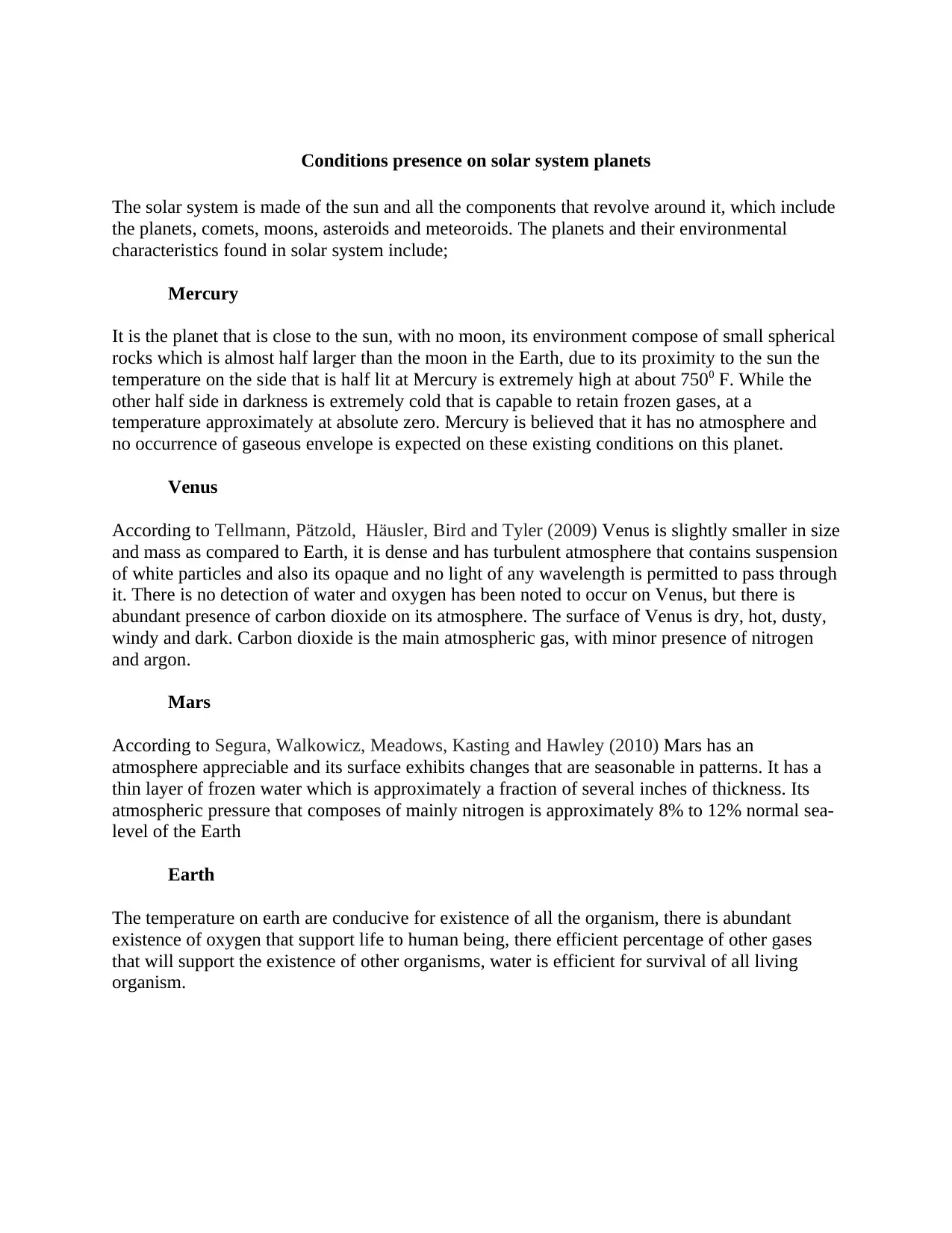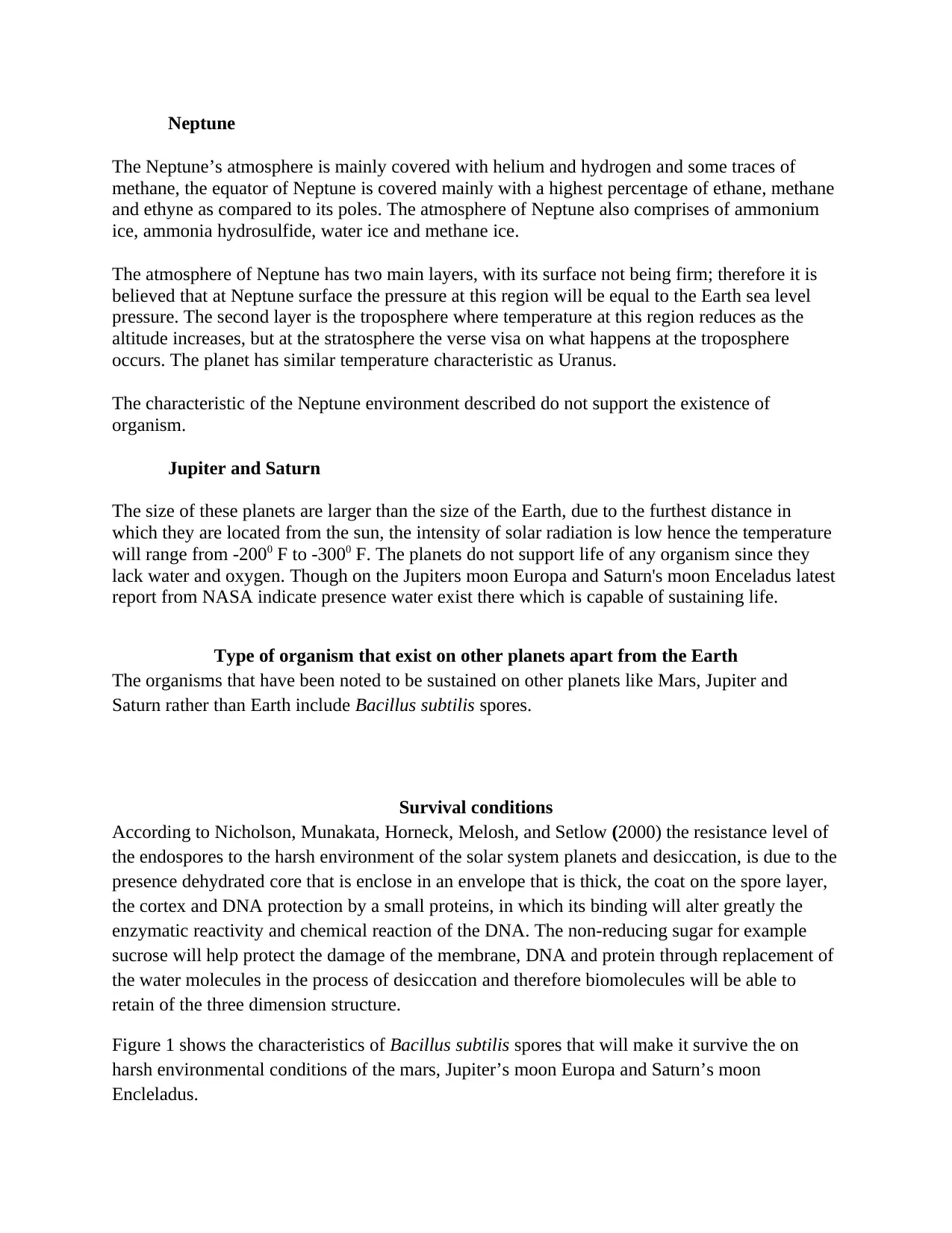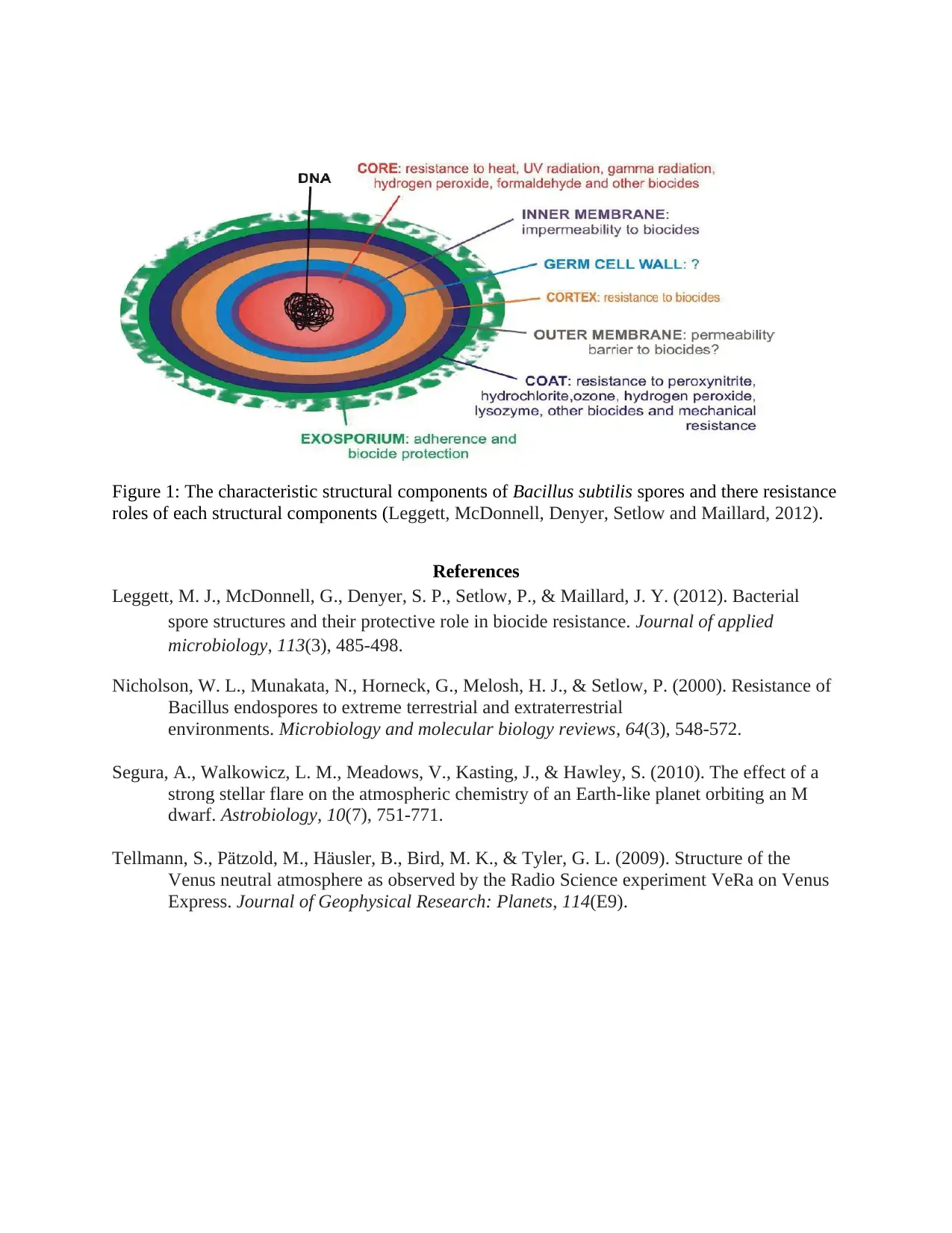Comparative Analysis: Environmental Conditions of Solar System Planets
VerifiedAdded on 2023/05/29
|3
|1093
|468
Report
AI Summary
This report provides a comparative analysis of the environmental conditions found on the planets within our solar system. It begins by describing the characteristics of Mercury, including its proximity to the sun and extreme temperature variations. The report then discusses Venus, highlighting its dense, turbulent atmosphere and lack of water. Mars is examined for its seasonal changes and thin atmosphere, while Earth's life-supporting conditions are contrasted with the harsh environments of Neptune, Jupiter, and Saturn. The report explores the presence of Bacillus subtilis spores as a potential form of life on other planets. The survival conditions of these spores, including the protective role of their dehydrated core, thick coat, and DNA protection, are also analyzed. The report references several scientific studies to support its findings, providing a comprehensive overview of the environmental challenges and potential for life beyond Earth.

Conditions presence on solar system planets
The solar system is made of the sun and all the components that revolve around it, which include
the planets, comets, moons, asteroids and meteoroids. The planets and their environmental
characteristics found in solar system include;
Mercury
It is the planet that is close to the sun, with no moon, its environment compose of small spherical
rocks which is almost half larger than the moon in the Earth, due to its proximity to the sun the
temperature on the side that is half lit at Mercury is extremely high at about 7500 F. While the
other half side in darkness is extremely cold that is capable to retain frozen gases, at a
temperature approximately at absolute zero. Mercury is believed that it has no atmosphere and
no occurrence of gaseous envelope is expected on these existing conditions on this planet.
Venus
According to Tellmann, Pätzold, Häusler, Bird and Tyler (2009) Venus is slightly smaller in size
and mass as compared to Earth, it is dense and has turbulent atmosphere that contains suspension
of white particles and also its opaque and no light of any wavelength is permitted to pass through
it. There is no detection of water and oxygen has been noted to occur on Venus, but there is
abundant presence of carbon dioxide on its atmosphere. The surface of Venus is dry, hot, dusty,
windy and dark. Carbon dioxide is the main atmospheric gas, with minor presence of nitrogen
and argon.
Mars
According to Segura, Walkowicz, Meadows, Kasting and Hawley (2010) Mars has an
atmosphere appreciable and its surface exhibits changes that are seasonable in patterns. It has a
thin layer of frozen water which is approximately a fraction of several inches of thickness. Its
atmospheric pressure that composes of mainly nitrogen is approximately 8% to 12% normal sea-
level of the Earth
Earth
The temperature on earth are conducive for existence of all the organism, there is abundant
existence of oxygen that support life to human being, there efficient percentage of other gases
that will support the existence of other organisms, water is efficient for survival of all living
organism.
The solar system is made of the sun and all the components that revolve around it, which include
the planets, comets, moons, asteroids and meteoroids. The planets and their environmental
characteristics found in solar system include;
Mercury
It is the planet that is close to the sun, with no moon, its environment compose of small spherical
rocks which is almost half larger than the moon in the Earth, due to its proximity to the sun the
temperature on the side that is half lit at Mercury is extremely high at about 7500 F. While the
other half side in darkness is extremely cold that is capable to retain frozen gases, at a
temperature approximately at absolute zero. Mercury is believed that it has no atmosphere and
no occurrence of gaseous envelope is expected on these existing conditions on this planet.
Venus
According to Tellmann, Pätzold, Häusler, Bird and Tyler (2009) Venus is slightly smaller in size
and mass as compared to Earth, it is dense and has turbulent atmosphere that contains suspension
of white particles and also its opaque and no light of any wavelength is permitted to pass through
it. There is no detection of water and oxygen has been noted to occur on Venus, but there is
abundant presence of carbon dioxide on its atmosphere. The surface of Venus is dry, hot, dusty,
windy and dark. Carbon dioxide is the main atmospheric gas, with minor presence of nitrogen
and argon.
Mars
According to Segura, Walkowicz, Meadows, Kasting and Hawley (2010) Mars has an
atmosphere appreciable and its surface exhibits changes that are seasonable in patterns. It has a
thin layer of frozen water which is approximately a fraction of several inches of thickness. Its
atmospheric pressure that composes of mainly nitrogen is approximately 8% to 12% normal sea-
level of the Earth
Earth
The temperature on earth are conducive for existence of all the organism, there is abundant
existence of oxygen that support life to human being, there efficient percentage of other gases
that will support the existence of other organisms, water is efficient for survival of all living
organism.
Paraphrase This Document
Need a fresh take? Get an instant paraphrase of this document with our AI Paraphraser

Neptune
The Neptune’s atmosphere is mainly covered with helium and hydrogen and some traces of
methane, the equator of Neptune is covered mainly with a highest percentage of ethane, methane
and ethyne as compared to its poles. The atmosphere of Neptune also comprises of ammonium
ice, ammonia hydrosulfide, water ice and methane ice.
The atmosphere of Neptune has two main layers, with its surface not being firm; therefore it is
believed that at Neptune surface the pressure at this region will be equal to the Earth sea level
pressure. The second layer is the troposphere where temperature at this region reduces as the
altitude increases, but at the stratosphere the verse visa on what happens at the troposphere
occurs. The planet has similar temperature characteristic as Uranus.
The characteristic of the Neptune environment described do not support the existence of
organism.
Jupiter and Saturn
The size of these planets are larger than the size of the Earth, due to the furthest distance in
which they are located from the sun, the intensity of solar radiation is low hence the temperature
will range from -2000 F to -3000 F. The planets do not support life of any organism since they
lack water and oxygen. Though on the Jupiters moon Europa and Saturn's moon Enceladus latest
report from NASA indicate presence water exist there which is capable of sustaining life.
Type of organism that exist on other planets apart from the Earth
The organisms that have been noted to be sustained on other planets like Mars, Jupiter and
Saturn rather than Earth include Bacillus subtilis spores.
Survival conditions
According to Nicholson, Munakata, Horneck, Melosh, and Setlow (2000) the resistance level of
the endospores to the harsh environment of the solar system planets and desiccation, is due to the
presence dehydrated core that is enclose in an envelope that is thick, the coat on the spore layer,
the cortex and DNA protection by a small proteins, in which its binding will alter greatly the
enzymatic reactivity and chemical reaction of the DNA. The non-reducing sugar for example
sucrose will help protect the damage of the membrane, DNA and protein through replacement of
the water molecules in the process of desiccation and therefore biomolecules will be able to
retain of the three dimension structure.
Figure 1 shows the characteristics of Bacillus subtilis spores that will make it survive the on
harsh environmental conditions of the mars, Jupiter’s moon Europa and Saturn’s moon
Encleladus.
The Neptune’s atmosphere is mainly covered with helium and hydrogen and some traces of
methane, the equator of Neptune is covered mainly with a highest percentage of ethane, methane
and ethyne as compared to its poles. The atmosphere of Neptune also comprises of ammonium
ice, ammonia hydrosulfide, water ice and methane ice.
The atmosphere of Neptune has two main layers, with its surface not being firm; therefore it is
believed that at Neptune surface the pressure at this region will be equal to the Earth sea level
pressure. The second layer is the troposphere where temperature at this region reduces as the
altitude increases, but at the stratosphere the verse visa on what happens at the troposphere
occurs. The planet has similar temperature characteristic as Uranus.
The characteristic of the Neptune environment described do not support the existence of
organism.
Jupiter and Saturn
The size of these planets are larger than the size of the Earth, due to the furthest distance in
which they are located from the sun, the intensity of solar radiation is low hence the temperature
will range from -2000 F to -3000 F. The planets do not support life of any organism since they
lack water and oxygen. Though on the Jupiters moon Europa and Saturn's moon Enceladus latest
report from NASA indicate presence water exist there which is capable of sustaining life.
Type of organism that exist on other planets apart from the Earth
The organisms that have been noted to be sustained on other planets like Mars, Jupiter and
Saturn rather than Earth include Bacillus subtilis spores.
Survival conditions
According to Nicholson, Munakata, Horneck, Melosh, and Setlow (2000) the resistance level of
the endospores to the harsh environment of the solar system planets and desiccation, is due to the
presence dehydrated core that is enclose in an envelope that is thick, the coat on the spore layer,
the cortex and DNA protection by a small proteins, in which its binding will alter greatly the
enzymatic reactivity and chemical reaction of the DNA. The non-reducing sugar for example
sucrose will help protect the damage of the membrane, DNA and protein through replacement of
the water molecules in the process of desiccation and therefore biomolecules will be able to
retain of the three dimension structure.
Figure 1 shows the characteristics of Bacillus subtilis spores that will make it survive the on
harsh environmental conditions of the mars, Jupiter’s moon Europa and Saturn’s moon
Encleladus.

Figure 1: The characteristic structural components of Bacillus subtilis spores and there resistance
roles of each structural components (Leggett, McDonnell, Denyer, Setlow and Maillard, 2012).
References
Leggett, M. J., McDonnell, G., Denyer, S. P., Setlow, P., & Maillard, J. Y. (2012). Bacterial
spore structures and their protective role in biocide resistance. Journal of applied
microbiology, 113(3), 485-498.
Nicholson, W. L., Munakata, N., Horneck, G., Melosh, H. J., & Setlow, P. (2000). Resistance of
Bacillus endospores to extreme terrestrial and extraterrestrial
environments. Microbiology and molecular biology reviews, 64(3), 548-572.
Segura, A., Walkowicz, L. M., Meadows, V., Kasting, J., & Hawley, S. (2010). The effect of a
strong stellar flare on the atmospheric chemistry of an Earth-like planet orbiting an M
dwarf. Astrobiology, 10(7), 751-771.
Tellmann, S., Pätzold, M., Häusler, B., Bird, M. K., & Tyler, G. L. (2009). Structure of the
Venus neutral atmosphere as observed by the Radio Science experiment VeRa on Venus
Express. Journal of Geophysical Research: Planets, 114(E9).
roles of each structural components (Leggett, McDonnell, Denyer, Setlow and Maillard, 2012).
References
Leggett, M. J., McDonnell, G., Denyer, S. P., Setlow, P., & Maillard, J. Y. (2012). Bacterial
spore structures and their protective role in biocide resistance. Journal of applied
microbiology, 113(3), 485-498.
Nicholson, W. L., Munakata, N., Horneck, G., Melosh, H. J., & Setlow, P. (2000). Resistance of
Bacillus endospores to extreme terrestrial and extraterrestrial
environments. Microbiology and molecular biology reviews, 64(3), 548-572.
Segura, A., Walkowicz, L. M., Meadows, V., Kasting, J., & Hawley, S. (2010). The effect of a
strong stellar flare on the atmospheric chemistry of an Earth-like planet orbiting an M
dwarf. Astrobiology, 10(7), 751-771.
Tellmann, S., Pätzold, M., Häusler, B., Bird, M. K., & Tyler, G. L. (2009). Structure of the
Venus neutral atmosphere as observed by the Radio Science experiment VeRa on Venus
Express. Journal of Geophysical Research: Planets, 114(E9).
⊘ This is a preview!⊘
Do you want full access?
Subscribe today to unlock all pages.

Trusted by 1+ million students worldwide
1 out of 3
Related Documents
Your All-in-One AI-Powered Toolkit for Academic Success.
+13062052269
info@desklib.com
Available 24*7 on WhatsApp / Email
![[object Object]](/_next/static/media/star-bottom.7253800d.svg)
Unlock your academic potential
Copyright © 2020–2025 A2Z Services. All Rights Reserved. Developed and managed by ZUCOL.




